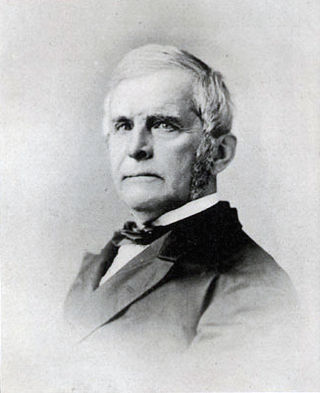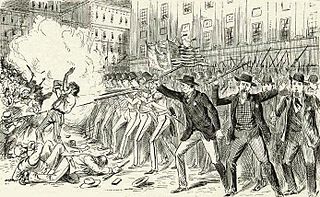
Jacob Aaron Westervelt was a renowned and prolific shipbuilder who constructed 247 vessels of all descriptions during his career of over 50 years. From 1853 until 1855 he was Mayor of New York City.

New York City Hall is the seat of New York City government, located at the center of City Hall Park in the Civic Center area of Lower Manhattan, between Broadway, Park Row, and Chambers Street. Constructed from 1803 to 1812, the building is the oldest city hall in the United States that still houses its original governmental functions. The building houses the office of the Mayor of New York City and the chambers of the New York City Council. While the Mayor's Office is in the building, the staff of thirteen municipal agencies under mayoral control are located in the nearby Manhattan Municipal Building, one of the largest government buildings in the world, with many others housed in various buildings in the immediate vicinity.

The Boston Police Department (BPD), dating back to 1838, holds the primary responsibility for law enforcement and investigation within the city of Boston, Massachusetts. It is the oldest municipal police department in the United States. The BPD is also the 20th largest law enforcement agency in the country.
James M. Smith Jr was an American lawyer and politician from New York.
The Tompkins Square Park riot occurred on August 6–7, 1988 in Tompkins Square Park, located in the East Village and Alphabet City neighborhoods of Manhattan, New York City. Groups of "drug pushers, homeless people and young people known as squatters and punks," had largely taken over the park. The East Village and Alphabet City communities were divided about what, if anything, should be done about it. The local governing body, Manhattan Community Board 3, recommended, and the New York City Parks Department adopted a 1 a.m. curfew for the previously 24-hour park, in an attempt to bring it under control. On July 31, a protest rally against the curfew saw several clashes between protesters and police.

Major General Charles W. Sandford was an American militia and artillery officer, lawyer and businessman. He was a senior officer in the New York State Militia for over thirty years and commanded the First Division in every major civil disturbance in New York City up until the American Civil War, most notably, the New York Draft Riots in 1863.

The Dead Rabbits riot was a two-day civil disturbance in New York City evolving from what was originally a small-scale street fight between members of the Dead Rabbits and the Bowery Boys into a citywide gang war, which occurred July 4–5, 1857. Taking advantage of the disorganized state of the city's police force—brought about by the conflict between the Municipal and Metropolitan police—the fighting spiraled into widespread looting and damage of property by gangsters and other criminals from all parts of the city. It is estimated that between 800 and 1,000 gang members took part in the riots, along with several hundred others who used the disturbance to loot the Bowery area. It was the largest disturbance since the Astor Place Riot in 1849 and the biggest scene of gang violence until the New York Draft Riots of 1863. Order was restored by the New York State Militia, supported by detachments of city police, under Major-General Charles W. Sandford.
John F. Dickson was an American public servant, law enforcement officer and police captain with the New York City Police Department. He and drillmaster Theron S. Copeland led a police squad during the New York Draft Riots which were dispatched against rioters attacking African-Americans. He was also the longtime head of the Tombs Police Court and one of the oldest serving police officers on the police force at the time of his death in 1880.
Daniel Denice Conover was an American public servant, political activist and industrialist. He was the first to invest in land development in Long Island and, through his efforts, was partly responsible for transforming the southern coastline, then known as the Great South Bay, as a popular summer resort for many prominent New York and Brooklyn families throughout the mid-to late 19th century.
Charles Devlin was an American contractor, bondsman and civil servant. He was the largest and one of the most successful city works contractors in New York City during the mid to late 19th century and was the bondsman of several prominent New Yorkers, including Boss Tweed and Henry W. Genet. His controversial appointment as city street commissioner over Daniel D. Conover resulted in the Police Riot of 1857.

The New York City Police Department (NYPD) originates in the Government of New York City attempts to control rising crime in early- to mid-19th-century New York City. The City's reforms created a full-time professional police force modeled upon London's Metropolitan Police, itself only formed in 1829. Established in 1845, the Municipal Police replaced the inadequate night watch system which had been in place since the 17th century, when the city was founded by the Dutch as New Amsterdam.

Charles McDonnell was an American law enforcement officer and police captain in the New York City Police Department. Popularly known as "Lightning Charlie", he was responsible for a number of high-profile arrests during the 1870s/80s, including those of procuress Jane the Grabber and gambler Samuel S. Brewster.
Jacob Westervelt was the Sheriff of New York County from 1831 to 1834. He was president of Lafayette Bank of New York City.
Daniel C. Carpenter was an American law enforcement officer and police inspector of the New York Police Department. He was one of earliest leading detectives on the police force during the mid-19th century and also had a prominent role in the Police Riot of 1857 and New York Draft Riots in 1863. His successful defeat of the rioters was the largest, and perhaps most crucial, battle during the riot. Fought in front of the Metropolitan Police headquarters, Carpenter's victory saved the New York financial district from falling into the hands of the rioters.
Francis C. Speight was an American law enforcement officer and police inspector for the New York City Police Department. A noted crimefighter, credited for running out the criminal elements from Manhattan's Eighteenth and Nineteenth Wards in the 1850s, he also took part in the Police Riot of 1857 and New York Draft Riots of 1863. Prior to the outbreak of violence at the Third Avenue draft office, Speight was the only officer to maintain control of his station, the Broadway draft office, during the early hours of the riots.
Thomas Woolsey Thorne was an American law enforcement officer and police inspector for the New York City Police Department. He is credited for breaking up the Daybreak Boys, a gang of river pirates active along the New York waterfront during the 1850s, by closing their dive bar headquarters in Slaughter House Point. He is also one of the commanding officers during the Draft Riots of 1863, in charge of the City Hall Police, and helped defend the New York Tribune.
Jacob B. Warlow was an American law enforcement officer, detective and police captain in the New York Police Department. A twenty-year veteran, he led police squads against rioters on the New York waterfront and later defended the New York Tribune during the New York Draft Riot of 1863.

Fernando Wood served as the 73rd and 75th Mayor of New York City from January 1, 1855 to December 31, 1857 and January 1, 1860 to December 31, 1861.
The Patrolmen's Benevolent Association Riot, also known as the City Hall Riot, was a rally organized and sponsored by the Patrolmen's Benevolent Association of the City of New York (PBA) held on September 16, 1992, to protest mayor David Dinkins' proposal to create a civilian agency to investigate police misconduct. Approximately 4,000 NYPD officers took part in a protest that included blocking traffic on the Brooklyn Bridge and jumping over police barricades in an attempt to rush City Hall. Rioters were observed to be openly drinking, damaging cars, and physically attacking journalists from the New York Times on the scene. Rioters also chanted racial epithets towards the African-American Mayor Dinkins. The nearly 300 uniformed on-duty officers did little to control the riot.








